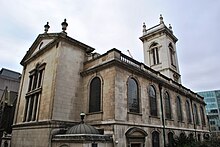St Andrew, Holborn
| St Andrew's Church, Holborn | |
|---|---|
 |
|
| Location | London, EC4 |
| Country | England |
| Denomination | Church of England |
| Churchmanship | Modern Catholic |
| Website | standrewholborn |
| Architecture | |
| Status | Active |
| Functional status | Guild Church |
| Heritage designation | Grade I listed |
| Designated | 4 January 1950 |
| Architect(s) | Sir Christopher Wren |
| Style | Baroque |
| Administration | |
| Deanery | The City |
| Archdeaconry | Archdeaconry of London |
| Diocese | Diocese of London |
| Clergy | |
| Vicar(s) | The Rt Revd Jonathan Baker (Guild Vicar) |
| Curate(s) | Fr Mark Young (Associate Guild Vicar) |
| Laity | |
| Director of music | James McVinnie |
| Churchwarden(s) | John Booth and Sue Johns |
The Church of St Andrew, Holborn is a Church of England church on the northwestern edge of the City of London, on Holborn within the Ward of Farringdon Without.
Roman pottery was found on the site during 2001/02 excavations in the crypt. However, the first written record of the church itself is dated as 951 (DCCCCLI) in a charter of Westminster Abbey, referring to it as the "old wooden church", on top of the hill above the river Fleet. The Charter's authenticity has been called into question because the date is not within the reign of the King Edgar of England who is granting it. It may be that this is simply a scribal error and that the date should be '959' (DCCCCLIX). A 'Master Gladwin', i.e. a priest, held it after the Norman Conquest and he assigned it to St Paul's Cathedral, but with the proviso that the advowson be granted at 12 pence a year to the Cluniac Order's, St Saviour's foundation of what was to become Bermondsey Abbey. This assignment dates between 1086 and 1089. In about 1200 a deed was witnessed by James, the Parson, Roger, his chaplain, Andrew, the Deacon and also Alexander his clerk. In 1280 one Simon de Gardino bequeathed funds towards the building of a belfry, it is assumed this would be stone and that there were due to be bells to be cast for it.
In the Early Middle Ages the church is referred to as St Andrew Holburnestrate and later simply as St Andrew de Holeburn.
In 1348, John Thavie, a local armourer, "left a considerable Estate towards the support of the fabric forever", a legacy which survived the English Reformation, was invested carefully through the centuries, and still provides for the church's current upkeep. In the 15th century, the wooden church was replaced by a medieval stone one. On 8 July 1563, during a severe storm, the steeple of the church was struck and badly damaged by lightning.
...
Wikipedia
